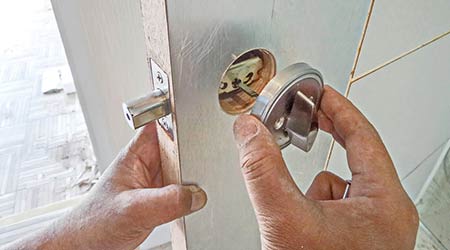Doors: Targeting Trouble Spots and Weaknesses
Comprehensive inspection, testing and maintenance helps managers enhance the safety of building occupants and visitors
Door latches, locks, knobs, hinges and lever handles are the most trouble-prone parts because they cycle so often. The most important component of keyed locks is the cylinder. Some high-end locks have cheap cylinders that can be opened in seconds with a bump key, which is made from any key that fits in the cylinder.
Home locks have five bumps, while commercial locks have six, providing more security. The highest-security lock keys also have either two rows of bumps or have offset bumps like a saw blade making them three-dimensional and bump-proof.
One common problem occurs when doors are blocked open at the hinges. This scenario can shorten performance lives and cause multiple additional failures. Blocking pulls the hinge screws out of the frame, and the door sags, causing the lock to misalign with the latch and the closer to misalign and fail. During inspection, technicians should check for signs of blocking.
Blocks placed under a door to hold it open can have the same unwanted results and result in multiple component failures. Blocking fire exit doors is illegal and might result in smoke and flame engulfing emergency exit routes, causing occupants to have to jump from upper windows, leading to injury and even death.
Another important inspection point is looking for signs of forced entry. Pry bars leave telltale marks on the mortise face and on the gap between the door and frame. If technicians discover evidence of forced entry, they should notify security personnel to change guard routes or redirect surveillance cameras for a better view.
Mortise lock and latch guards are effective means to prevent forcing the lock open. These guards also cover the gap between the door and frame at the lock location. Technicians also can install locking hinge pins to deter attempts to remove pins to gain entry.
Maintenance and repair
Comprehensive preventive inspection and maintenance is the most effective way to ensure peak door hardware performance. Regular cleaning, checking, adjusting and lubricating – applying dry graphite in lock cylinders if keys are sticking — go a long way.
Technicians should check door alignment every one-three months, depending on cycle frequency. Maintaining good alignment ensures longer life by eliminating binding shock and slamming and that secure latching occurs.
They also should inspect door checks for proper closing rates. If it closes too hard and the door slam, results can be loosening, misalignment and early failure. If it closes too softly, the door will not latch all the way, or wind can cause partial opening and loss of building heat and drafts, as well as security issues.
Closers have a set screw that might require adjusting every one-three months. Technicians can turn it a fraction of a revolution clockwise to slow the closure rate and counterclockwise to speed up the closure rate.
Technicians should inspect hinges every six months. Hinges can loosen from frequent door use and might need to be tightened. Doing this before the door gets too far out of line can save a great deal of wear and tear on hinges and the doors.
They also should inspect the crash bar linkage and seats and retighten when the door alignment and check closure is adjusted. Keeping the linkages tight minimizes wear and extends performance life.
Inspection frequency varies with the type of door. Retail stores, airports and similar high-traffic locations with powered revolving, sliding, or hinged doors require daily inspections. The first indication that problems are about to occur is that hardware looseness, excessive play develops between the door and frame, or components bind. If not adjusted, the problem will worsen, and the components will fail. It is better to make a minor adjustment and quickly solve a problem frequently than to delay and have to perform a major replacement.
When the same hardware too often requires repairs, it is the time to check codes and suppliers for hardware that is better suited for the application. For example, the hardware on a frequently used entry or egress point might be changed from a lever handle to an easier-to-operate paddle latch without changing the lock.
Thomas A. Westerkamp is a maintenance and engineering management consultant and president of the work management division of Westerkamp Group LLC.
Related Topics:















